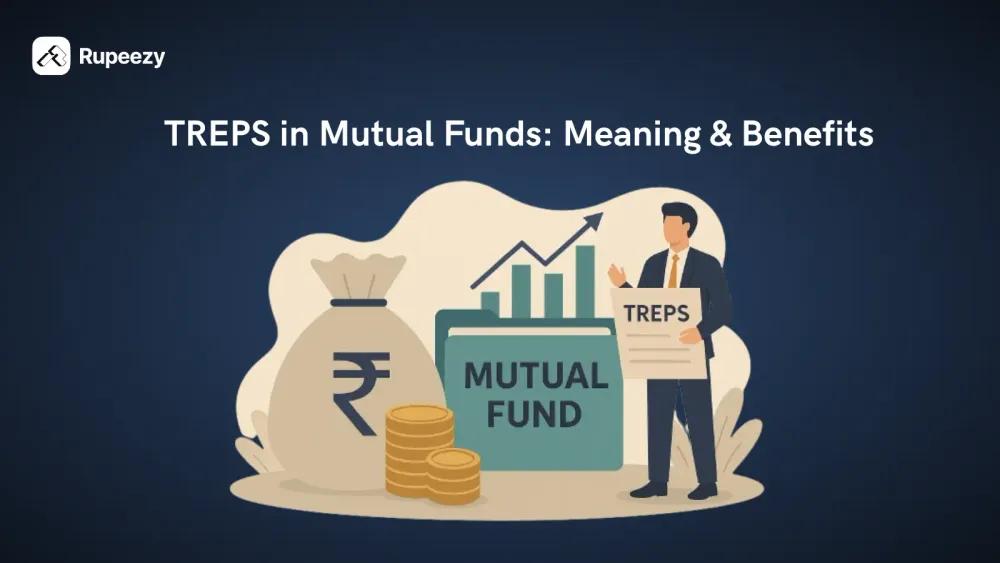TREPS in Mutual Funds: Meaning & Benefits


00:00 / 00:00
If you invest in mutual funds, you might have seen “TREPS” listed in your fund's holdings, but have you ever wondered what it is? Essentially, it's a system that provides your fund with daily liquidity, or the ability to access cash quickly. When fund managers want to park money for a short period, they invest it in TREPS safe, regulated, and short-term investment options. In this blog, we'll explain in simple terms what TREPS is, how it works, and why it's important for your mutual fund.
What is TREPS in Mutual Funds?
TREPS stands for Triparty Repo, which, in simple terms, is a short-term borrowing and lending system. It involves three parties: the borrower (who borrows the money), the lender (who lends the money), and CCIL (Clearing Corporation of India Ltd.), which acts as an intermediary, ensuring the security and monitoring of the entire transaction. In simpler terms, when a mutual fund has extra cash for a short period, it parks that money in TREPS. Here, the fund lends the money to an institution, and in return, government securities (such as Treasury Bills or G-Secs) are pledged as collateral. The next day, or at the agreed time, the institution returns the money along with interest essentially, it's a repurchase agreement, which is fully regulated and secure.
TREPS was implemented in 2018 by the RBI and CCIL to replace the older system, CBLO (Collateralized Borrowing and Lending Obligation), to make money market transactions more transparent and secure. Today, almost all mutual funds use TREPS for their liquidity management.
How Do TREPS Work?
Step-1: Idle Cash in Mutual Funds
When a mutual fund has temporarily unutilized cash (idle cash), such as inflows from investors or money available for future investments, it doesn't simply leave that money in a bank account but decides to park it in a safe place for a short period.
Step-2: Lender & Borrower Repo Setup
The fund acts as the lending party ('lender'), and the borrowing party ('borrower') is the institution that needs temporary funds. This lending arrangement occurs when the borrower pledges government securities as collateral and agrees to repurchase them at a predetermined price and time.
Step-3: Role of the Third Party
This arrangement is called triparty because it involves a third party, CCIL (Clearing Corporation of India Ltd.), which handles the transaction, security valuation, payment, and settlement process. This arrangement increases transparency and security.
Step-4: Repurchase and Benefit to India
The lender (mutual fund) provides the cash, the borrower provides the security as collateral, and after a specified time (often overnight or a few days), the borrower repays the money with interest at the predetermined price and retrieves the security. In this process, the mutual fund earns a small but secure profit on this cash.
Step-5: Use in Fund Manager's Strategy
Such TREPS transactions are used by mutual funds for liquidity management, earning safe returns, and fulfilling regulatory requirements (such as those stipulated by the Securities and Exchange Board of India/SEBI).
Why Do Mutual Funds Invest in TREPS?
To maintain liquidity:
Every mutual fund is required to keep a portion of its portfolio in cash or liquid assets so that when investors redeem their units, the fund has the money to pay them immediately. TREPS help in this because they are overnight instruments, meaning the fund can withdraw the money the very next day.
For safety and stability:
TREPS are entirely based on Government Securities. This means the default risk is almost zero. Therefore, it is considered the safest option for fund managers to park their money.
For better returns on cash:
Cash lying in a bank usually earns very little interest, while TREPS offer overnight interest. This ensures that the fund's idle cash also earns a return and contributes to the fund's overall income.
Regulatory Compliance:
Under SEBI's liquidity norms, every fund house is required to keep a portion of its total assets in high-quality, short-term, and liquid instruments. TREPS fully meet this requirement.
Flexibility in Fund Management:
TREPS allow fund managers to balance their inflows and outflows. Until they find the right opportunity for long-term investments, they park their money in TREPS, ensuring safety, liquidity, and yield all three simultaneously.
Where Are TREPS Used?
Use in Debt Mutual Funds :
TREPS is most widely used in debt funds, especially in overnight, liquid, and ultra-short duration funds, where money is invested for very short periods. For these funds, TREPS is a safe and liquid option, providing them with both daily returns and stability.
Use in Equity Mutual Funds :
Equity funds also park their temporary cash inflows in TREPS. Until the fund manager identifies suitable opportunities to buy shares, this money is invested in TREPS so that it doesn't remain idle and earns some interest.
Use in Hybrid and Arbitrage Funds :
Hybrid and arbitrage funds need to maintain a balance between their equity and debt holdings. Therefore, these funds keep a portion of their assets in TREPS so that they can access immediate liquidity when needed, especially during market volatility.
Use in ETFs (Exchange Traded Funds) :
ETF fund managers also use TREPS, particularly during the unit creation or redemption process. This helps the fund manage temporary cash flows efficiently and prevents delays in transactions.
Benefits of TREPS in Mutual FundsHigh Safety
TREPS is collateralized by government securities and is fully regulated by the RBI and CCIL (Clearing Corporation of India Ltd.). This results in a near-zero default risk. This is why fund managers consider it the most reliable way to park funds.
Instant Liquidity
TREPS typically have an overnight or short-term maturity. This means that mutual funds can withdraw their funds from TREPS the very next day whenever they need the money. This ensures that the fund is always ready to meet investors' redemption needs.
Competitive Returns
Cash held in bank accounts earns very little interest, while the overnight interest rate on TREPS is usually higher. Thus, it not only provides security but also ensures a little extra return on the fund's idle cash.
Transparent and Secure Settlement
In TREPS transactions, CCIL acts as a third party, monitoring the entire settlement process, ensuring that both money and securities are exchanged on time and securely. This eliminates counterparty risk.
Efficient Fund Operation
TREPS allows fund managers to manage their cash flow more effectively. This keeps the fund's NAV stable and prevents unnecessary fluctuations in returns. This is why almost every fund house uses TREPS for its short-term liquidity management.
Risks & Limitations of TREPS
Interest Rate Fluctuations :
TREPS is an overnight instrument, so its interest rates can change daily. If market liquidity decreases or there are changes in RBI policies, the return rate of TREPS can also be affected. Although this impact is usually small, minor fluctuations may be observed in the daily NAV of liquid and overnight funds.
Limited Tenure :
TREPS are used only for very short periods, typically one day or a few days. Therefore, it is not a long-term investment tool. Investors seeking better yields over the long term should consider other debt instruments such as bonds or commercial papers.
Lack of Portfolio Diversification (Concentration Risk) :
If a significant portion of a fund is consistently held in TREPS, the portfolio's diversification may be reduced. This will keep the fund's returns stable, but limit growth opportunities.
Almost Zero Default Risk :
Despite the limitations mentioned above, the biggest advantage of TREPS is its level of security. Because all transactions are backed by government securities and settled by CCIL, the possibility of any default is almost negligible.
Conclusion
In simple terms, TREPS acts like a reliable backup system for mutual funds. It safeguards the fund's money, maintains liquidity, and even generates a little extra income. When investors withdraw their money, this system helps the fund make prompt payments. Therefore, if you invest in mutual funds, understanding TREPS is crucial because it's the silent force that makes your fund stable and trustworthy.
FAQs
Q1. What are TREPS in mutual funds?
TREPS is a short-term system where mutual funds invest their money overnight in a secure manner and earn interest on it.
Q2. Why do mutual funds invest in TREPS?
Funds invest in TREPS to ensure the safety of their money, maintain liquidity, and earn a small return on idle cash.
Q3. Is TREPS safe?
Yes, it is very safe because it is backed by government securities and regulated by CCIL.
Q4. Do all mutual funds use TREPS?
Most funds, especially liquid and debt funds, use TREPS to manage their cash.
Q5. Does TREPS impact NAV?
Yes, it has a slight impact because the daily change in NAV depends on the interest rate of TREPS.
The content on this blog is for educational purposes only and should not be considered investment advice. While we strive for accuracy, some information may contain errors or delays in updates.
Mentions of stocks or investment products are solely for informational purposes and do not constitute recommendations. Investors should conduct their own research before making any decisions.
Investing in financial markets are subject to market risks, and past performance does not guarantee future results. It is advisable to consult a qualified financial professional, review official documents, and verify information independently before making investment decisions.

All Category









